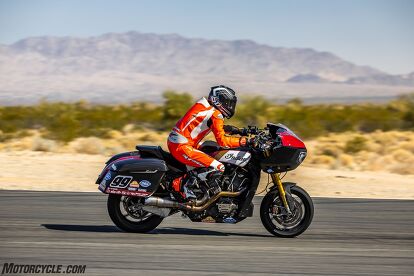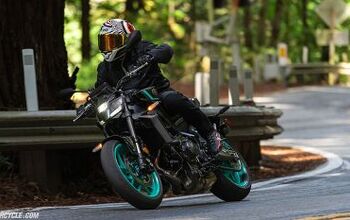Riding Indian's 2022 Championship-Winning Challenger Bagger Race Bike

The race bagger from the other American motorcycle company.
The Harley-Davidson vs. Indian rivalry is a great American classic on par with the likes of Army vs. Navy, Lakers vs. Celtics, Ford vs. Chevy, Pepsi vs. Coke, and even…Google vs. Bing? Ok, maybe not that last one, but you get the point. Harley and Indian have been at each other’s throats going back over a century, save for a 50-odd-year pause in the middle when Indian originally closed its doors. But when Polaris bought the keys to the palace and opened the doors again, the fight resumed as intense as ever when the FTR750 flat tracker started beating Harley’s legendary XR750. Repeatedly.
2022 Indian Challenger Bagger Race Bike
+ Highs
- Changes direction better than anything this big has a right to
- Slick transmission
- It’s a superbike in baggy clothes
– Sighs
- Chassis flex is real
- Engine gets really buzzy at high rpm (I have no idea how they see straight at Daytona)
- I wish I had more time on it
Naturally, the rivalry continued over to the asphalt as the King of the Baggers class – originally slated to be a one-off race at Laguna Seca – became such a hit that MotoAmerica tapped it to become part of select rounds on the calendar. With that, the game was on. Harley struck first, winning the 2021 championship with Kyle Wyman aboard the Screaming Eagle Factory Road Glide. Then, in 2022, Indian struck back, taking the title with Tyler O’Hara aboard the Challenger Bagger.
Motorcycle.com would like to thank Motorcycle Mechanics Institute | MMI for sponsoring this video.
Impressive, yes, but it’s hard to completely understand what goes into these baggers to make them do what they do – hence why Indian invited Yours Truly to come see the 2022 championship-winning Challenger baggers, and even take one for a spin.
A True American Hot Rod
Transforming an Indian Challenger into not only a race bike, but a championship-winning race bike able to fight – and win – against the might of Harley-Davidson is no easy task. Indian teamed up with S&S Cycles to build these bikes, with S&S Head Honcho Jeff Bailey also the Chief Engineer of the project. In terms of the modifications and engineering, these are full-on superbikes. Just in different clothes.
King Of The Baggers: Riding The Harley-Davidson Screamin’ Eagle Factory Road Glide Race Bike
Per the rules, the main frame is still stock. The shape of the frame-mounted fairing is also the same but is made from lighter materials. The headlights themselves are gone and a vinyl sticker application gives it the appearance of having the stock lights. And that’s just the start of where the line gets blurred between stock and modified.
Race teams are always coy when talking about what’s under the hood, and Indian’s clever wordplay states that the “core engine” is still retained from stock, but we all know there’s nothing stock about it. For starters, the crankcase main bearings are locked into place to help with reliability. There are custom camshafts, 110mm big bore pistons and cylinders, CNC ported heads, and billet manual lash adjuster rocker arms – and that’s just what the team were willing to tell us. Other than the main bearings being fixed, there’s no word on whether the crankshaft is stock, modified, or different altogether.
Technically, the swingarm is the stock piece, but it’s been heavily braced and strengthened to cope with the added power and cornering forces being sent through it. Unlike Harley-Davidson, who CNC machined an all-new swingarm out of billet, you can clearly see remnants of the Indian Challenger swingarm still there, under all the bracing.
Employing a clever bit of racecraft, the fuel tank is also the stock piece – technically. But it’s been sliced in half down the middle, with a section taken out, and the two sides squished back together. The fuel sender has also been moved from the right side of the tank to the left in order to make space for the air cleaner, the upper tip of which tucks under the tank, and enormous 70mm throttle body sticking out the right side of the engine. For 2023, the air cleaner juts out and forward from the throttle body, relieving the space under the tank.
According to Indian, the radiator and transmission are also leftovers from the stock Challenger, though there’s no word as to whether more rows were added to the former to help with cooling. There’s also a quickshifter on the transmission – something conspicuously missing from the Harley.
S&S stepped in and, with the help of chassis tech Kyle Ohnsorg, an accomplished racer whose day job is working at Indian, made the bike handle better than anything this big has the right to. Massive adjustable billet machined triple clamps get the front wheel positioned like it should, and swingarm angle is adjusted, too. There’s Öhlins suspension front and rear, which also serve to raise the bike for additional cornering clearance. Still, Indian had to request special dispensation from MotoAmerica to modify the bottom of the frame, under the radiator, for additional clearance since its riders were scraping it on the ground during testing.
Other goodies include a billet front axle, modified air induction system (mentioned earlier), a 2-into-1 stainless steel exhaust, a billet clutch cover with the cable pull mechanism relocated from the bottom to the top of the case for additional ground clearance, trick billet rearset foot controls (mounted essentially where the passenger pegs would be on the standard Challenger), the custom handlebar assembly to suit factory riders Jeremy McWilliams and Tyler O’Hara, custom bellypan, a chain conversion (for more gearing options depending on the track) and subsequent chain tensioner, rear brake caliper hanger, rear axle assembly, and the adjustable fairing mount.
The race team experimented with several different brake options from practically every manufacturer under the sun. The 2022 bike we rode wore Brembo Stylema calipers on dual Brembo T-Slot rotors, Spiegler brake lines, and a Galespeed 19×19 master cylinder. A Hayes caliper is used in the rear. A series of wheel manufacturers were used, too, but the bikes we rode were sitting on Dymag UP7X forged aluminum wheels measuring 17” x 3.5” in front and 17” x 6” in the rear. For this particular test, which was conducted in cold and windy conditions, the wheels wore Dunlop Q4 trackday tires. Normally they wear Dunlop slicks. Rounding out the trick bits are a custom seat by Saddlemen, carbon fiber saddlebags, a fiberglass rear fender, and an AIM DL2 dash display/datalogger.
Riding The Beast
There’s nothing that can really prepare you for the experience of riding a bagger that’s been heavily modified to not only race – but to win. This is a world where 520-something pounds is considered light, where the feeling of piloting a school bus is considered normal, and the overwhelming sensation that none of this is right… is completely perfect. I was assigned the number 99 bike, piloted by Jeremy McWilliams – one of my childhood heroes. Having raced everything under the sun, including two- and four-stroke MotoGP bikes, McWilliams is nearly 60 years old and still tearing it up on whatever he’s able to get his hands on, including factory baggers. It was an honor to get a taste of his office.
Riding a bike this big and this rare on a racetrack is scary and intimidating enough as it is. The cold and windy conditions zapped my confidence even more. With only 15 minutes with the bike at my disposal, there would be a lot to accomplish in a short amount of time.
The biggest adjustment was simply accounting for how large the Challenger really is. In a world where sportbikes are trying to be as small and narrow as possible, sitting on the Indian and looking at the tank, bars, and huge front fairing in front of me brought me back to grade school, where I’d sit at huge desks large enough to fit all my third grade arts and crafts right on top. It made no sense, and yet it made perfect sense. The reach to the bars is farther away than I remember on the Harley bagger I rode a year prior, exacerbating that feeling of largeness.
Concurrently, while adjusting to the size of the bike is acclimating to the power. Or, more specifically, the torque. Sure these bikes are making power (I wasn’t told directly, but the estimation is around 150 hp), but big V-Twins are all about torque. The Challenger Bagger scoots along with an urgency you don’t expect from something this big, but years of sportbike riding engrained the habit of revving an engine as high as it’ll go before changing gears. To Indian’s credit, the slick-shifting transmission is happy to do it as its quickshifter makes rowing up through the gears really easy – despite me taking a full lap to adjust to the tiny shifter McWilliams prefers on his bike (downshifts are still done with the clutch).
But riding it this way has two downsides. First, this engine is stressed enough as it is. When those two huge jugs get spinning close to redline, the vibrations coming up through the bars is something fierce. Enough to make my vision blurry. Second, revving that high doesn’t let you take advantage of all the torque at your disposal. As I let the bike stay a gear high, I quickly learned I wasn’t in the wrong gear after all. There’s plenty of torque to pull me along, even if the auditory cues of a bike loping along aren’t what I’m used to on a racetrack.
After two laps to wrap my head around the size and power, and to give the tires time to warm up, I started to feel more comfortable pushing a little more. This is when another shock hit me: the bike was incredibly easy to turn. In fact, it initiates a turn and changes direction quicker than anything this big has a right to. Going in I expected a big, burly motorcycle. The Indian’s nimbleness is impressive – and not just for something so big. It’s simply impressive.
If there is a chink in the armor, it’s the bolted frame construction between the main frame and the subframe. None of this is allowed to be modified, and unlike the solid one-piece frame construction of the Harley, with the Indian, you can feel the chassis twisting once you get moving at a serious pace and combine lateral cornering forces with giant V-Twin torque. It’s an eye-opening experience the first time you encounter it because you think something is wrong, like a tire that’s still cold. I would have fallen for that trap if chassis tech and racer Kyle Ohnsorg hadn’t warned me about it earlier in the day.
Once I was fairly confident the tires had some temperature in them, I could anticipate the flexing in the frame, and though I was never fully comfortable with it, I could adjust my riding to mitigate its effects. Of course, this is easy to say for someone with no intentions of racing one of these things. It really highlights how heroic (or stupid) McWilliams, O’Hara, and really anyone who races a bagger is, that they can push these things to some mightily lap times.
Brakes can get overlooked as a pivotal piece to the racebike puzzle – until you actually need them. Clearly, with this much mass to slow, only the best brakes will do, and lap after lap I could get the Indian slowed with no reservations or worries. The braking feel was firm, feedback was crisp, and there wasn’t a hint of fade to be found. Once again, impressive is the best word that comes to mind.
Kudos to the Champ
As my brief time with the Indian Challenger bagger came to an end, I laughed at myself for being so intimidated by it. Yes it’s big and burly, but it rides like an absolute sweetheart. The V-Twin thrust is ridiculous, and the nimble handling just shouldn’t be possible. Of course, this comes after riding the bike at Chuckwalla Valley Raceway, which doesn’t have much in terms of long straights. Replace Chuckwalla with Daytona and my mind is once again boggled at what these bikes – and their pilots! – are able to do.
As one of the few very lucky people who have had the privilege of being able to ride both the Harley and Indian baggers, drawing comparisons is only natural. With only a short time on each (although both in cold conditions, ironically enough), it’s hard to drill down micro differences. On a macro level, however, it felt to me like the Harley had the more stable chassis thanks to its solid construction, and fired out of corners better. To the Indian’s credit, it wins on initial turn-in, top-end speed, and has a better transmission. Considering both O’Hara and McWilliams have had the best seats in the house when it comes to analyzing their competition, they both echoed the same sentiments when comparing their bike against their rival’s.
When the bagger series was first announced, critics were everywhere. Hell, I was one of them. A few years in and several races later, I can say I’m a convert. The machinery is super trick, the riders are super human, and best of all, the racing is actually really good. It just goes to show that if you try hard enough, you can race pretty much anything.
In Gear

- Helmet: 6D ATS-1R Aero
- Suit: Alpinestars Racing Absolute
- Airbag: Alpinestars Tech-Air 5
- Gloves: Alpinestars GP Tech v2
- Boots: Alpinestars Supertech R Vented Boots
We are committed to finding, researching, and recommending the best products. We earn commissions from purchases you make using the retail links in our product reviews. Learn more about how this works.
Become a Motorcycle.com insider. Get the latest motorcycle news first by subscribing to our newsletter here.

Troy's been riding motorcycles and writing about them since 2006, getting his start at Rider Magazine. From there, he moved to Sport Rider Magazine before finally landing at Motorcycle.com in 2011. A lifelong gearhead who didn't fully immerse himself in motorcycles until his teenage years, Troy's interests have always been in technology, performance, and going fast. Naturally, racing was the perfect avenue to combine all three. Troy has been racing nearly as long as he's been riding and has competed at the AMA national level. He's also won multiple club races throughout the country, culminating in a Utah Sport Bike Association championship in 2011. He has been invited as a guest instructor for the Yamaha Champions Riding School, and when he's not out riding, he's either wrenching on bikes or watching MotoGP.
More by Troy Siahaan












































































Comments
Join the conversation
That fake headlight.. I can't unsee it anymore.
Amazing machines, but this fake stuff always gets me mad.
I am a fan of a wide range of bikes, but I just don't get the appeal of high-performance track ready baggers. It is a major disconnect from the original purpose of baggers. Maybe it is the same thing as racing school buses on quarter ovals but it's weird.